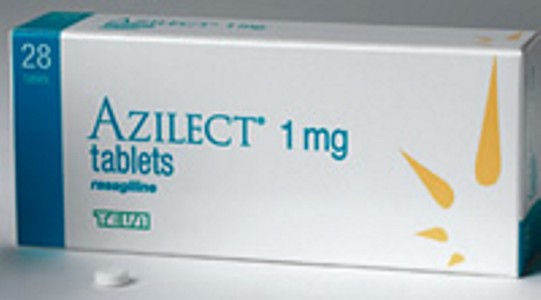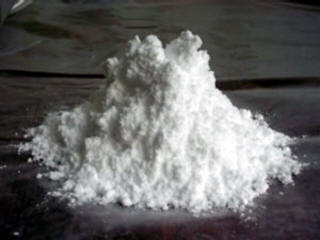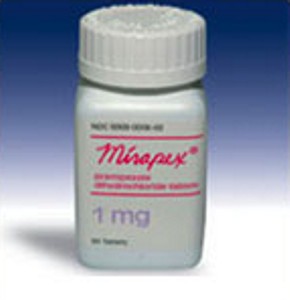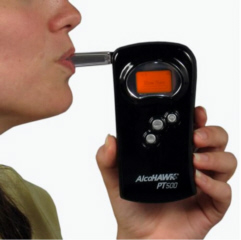.gif) VIARTIS � |
||||||
|
PARKINSON'S DISEASE |
||||||
| � � |
||||||
|
� � � � |
PARKINSON'S DISEASE NEWS � |
� � � � � � � � � � � � � � � |
||||
|
JUNE 2013 ������������������ ������������������������������������������������������������������������������������������������������������������������������ 24th June 2013 - New research RASAGILINE'S EFFECT ON TREMOR IN PARKINSON'S DISEASE The International Journal of Neuroscience [2013] Jun 17 [Epub ahead of print] (M.F.Lew) Complete abstract Researchers reviewed the effects on tremor in Parkinson's Disease of 1mg daily oral rasagiline, on its own and with other treatments. Tremor is a common symptom of Parkinson's Disease, but it is less responsive to dopaminergic therapy than are the symptoms of bradykinesia and rigidity. Rasagiline is a MAO inhibitor that is marketed as Azilect. For more information go to Azilect.
In people taking L-dopa who had motor fluctuations who were already receiving optimal dopaminergic treatment, the addition of rasagiline significantly improved their tremor. Significant improvement was evident as early as ten weeks from the initiation of the use of rasagiline. Tremor symptoms also improved in people with severe tremor when rasagiline was added to their existing Parkinson's Disease treatments. The researchers contend that the data suggest that rasagiline used on its own or alongside other treatments is effective for reducing tremor severity in people with Parkinson's Disease. For a printable version of this articlee click here. In order to refer to this article on its own click here. � 19th June 2013 - New research SWEETENER FOR TREATING PARKINSON'S DISEASE Journal of Biological Chemistry [2013] 288 (24) : 17579-17588 (R.Shaltiel-Karyo, M.Frenkel-Pinter, E.Rockenstein, C.Patrick, M.Levy-Sakin, A.Schiller, N.Egoz-Matia, E.Masliah, D.Segal, E.Gazit)��� Complete abstract The sweetener, mannitol, has been proposed as a potential means of treating Parkinson's Disease because of the dual mechanisms it has in the brain. Mannitol, which is used in medicine, is derived from mannose, which is a sugar. For more information go to Mannitol.
The researcherssstherefore suggest mannitol as a basis for a dual mechanism therapeutic agent for the treatment of Parkinson's Disease. However, the research was� only carried out on mice and flies, who did not have Parkinson's Disease and who were not rid of its symptoms. For a printable version of this articlee click here. In order to refer to this article on its ownnn click here. � 13th June 2013 - New research THE EFFECT OF PRAMIPEXOLE ON PARKINSON'S DISEASE Lancet Neurology [2013] May 30 [Epub ahead of print] (A.H.Schapira, M.P.McDermott, P.Barone, C.L.Comella, S.Albrecht, H.H.Hsu, D.H.Massey, Y.Mizuno, W.Poewe, O.Rascol, K.Marek) ���Complete abstract The Pramipexole On Underlying Disease (PROUD) study was designed to identify whether or not early versus delayed pramipexole initiation has clinical benefits in people with Parkinson's Disease. Pramipexole, which is sold as Mirapex, Mirapexin and Sifrol, is aaa dopamine agonist used for treating early-stage Parkinson's Disease. For more information go to Mirapex.
� 5th June 2013 - New research BREATH TEST TO DIAGNOSE PARKINSON'S DISEASE Nanomedicine [2013] 8 (1) : 43-56 (U.Tisch, I.Schlesinger, R.Ionescu, M.Nassar, N.Axelrod, D.Robertman, Y. Tessler, F.Azar, A.Marmur, J.Aharon-Peretz, H.Haick)� ���Complete abstract
A method of diagnosing Parkinson's Disease has been developed that uses breath
testing. It can identify Parkinson's Disease and Alzheimer's Disease. Alveolar
breath was collected from people with Parkinson's Disease or Alzheimer's Disease
or who had neither. Their breath was analyzed using sensors (organically
functionalized carbon nanotubes and gold nanoparticles). Statistically
significant differences were compared between the different groups, which was
supported by chemical analysis of the breath samples using gas chromatography
combined with mass spectrometry. �
��
|
||||||
| � | ||||||
.gif) |
||||||
| � | ||||||
| �2006-2013 Viartis | ||||||
| � | ||||||
| [email protected]� | ||||||
 Of
22 identified publications, 2 large placebo-controlled trials of rasagiline
monotherapy (TEMPO and ADAGIO) and 2 large placebo controlled trials of
rasagiline with L-dopa (PRESTO and LARGO) specifically evaluated the effect of
rasagiline on tremor using the Unified Parkinson's Disease Rating Scale (UPDRS).
Analysis of these studies showed rasagiline on its own significantly improved
tremor in early Parkinsons' Disease independently of disease duration.
Of
22 identified publications, 2 large placebo-controlled trials of rasagiline
monotherapy (TEMPO and ADAGIO) and 2 large placebo controlled trials of
rasagiline with L-dopa (PRESTO and LARGO) specifically evaluated the effect of
rasagiline on tremor using the Unified Parkinson's Disease Rating Scale (UPDRS).
Analysis of these studies showed rasagiline on its own significantly improved
tremor in early Parkinsons' Disease independently of disease duration. Researchers
assessed the ability of mannitol to (1) interfere with the aggregation of
alpha-synuclein, and (2)� its ability to disrupt the blood-brain barrier.
Alpha-synuclein can accumulate in the brains of people with Parkinson's Disease
and other medical disorders but can also be absent in Parkinson's Disease. It
therefore appears that Parkinson's Disease can cause alpha-synuclein rather than
alpha-synuclein being the cause of Parkinson's Disease as is often claimed. The
blood brain barrier restricts access to the brain to certain substances. They
demonstrated the effect of mannitol on alpha-synuclein by various means, and a
decrease in alpha-synuclein accumulation.
Researchers
assessed the ability of mannitol to (1) interfere with the aggregation of
alpha-synuclein, and (2)� its ability to disrupt the blood-brain barrier.
Alpha-synuclein can accumulate in the brains of people with Parkinson's Disease
and other medical disorders but can also be absent in Parkinson's Disease. It
therefore appears that Parkinson's Disease can cause alpha-synuclein rather than
alpha-synuclein being the cause of Parkinson's Disease as is often claimed. The
blood brain barrier restricts access to the brain to certain substances. They
demonstrated the effect of mannitol on alpha-synuclein by various means, and a
decrease in alpha-synuclein accumulation.
 People taking pramipexole were given 1.5mg pramipexole per day. The average
difference in Parkinson's Disease symptom scores (the UPDRS) showed no
significant difference between early and delayed pramipexole. Fifteen months of
use showed no benefit when compared to the use of pramipexole being delayed for
6 to 9 months. Over 80% of people who took pramipexole reported adverse events,
with 81% of those given early pramipexole and 84% of those given delayed
pramipexole. The most frequent adverse event was nausea.� Serious adverse
events were reported by 10% of people in the early pramipexole group and 8% in
the delayed pramipexole group.
The authors conclude that the results do not support the hypothesis that
pramipexole has disease-modifying effects.
For a printable version of
this articlee
People taking pramipexole were given 1.5mg pramipexole per day. The average
difference in Parkinson's Disease symptom scores (the UPDRS) showed no
significant difference between early and delayed pramipexole. Fifteen months of
use showed no benefit when compared to the use of pramipexole being delayed for
6 to 9 months. Over 80% of people who took pramipexole reported adverse events,
with 81% of those given early pramipexole and 84% of those given delayed
pramipexole. The most frequent adverse event was nausea.� Serious adverse
events were reported by 10% of people in the early pramipexole group and 8% in
the delayed pramipexole group.
The authors conclude that the results do not support the hypothesis that
pramipexole has disease-modifying effects.
For a printable version of
this articlee
 The combinations of sensors could distinguish Parkinson's Disease from healthy
states (with an accuracy of 78%), Alzheimer's Disease from healthy states (with
an accuracy of 85%), and Parkinson's Disease from Alzheimer's Disease (with an
accuracy of 84%). Gas chromatography combined with mass spectrometry analysis
was able to show statistically significant differences in the average level of
several volatile organic compounds in the breath of people with Parkinson's
Disease, thus supporting the breath prints observed with the sensors. The method
therefore has future potential as a cost-effective, fast and reliable means of
assisting the diagnosis of Parkinson's Disease.
For a printable version of
this articlee
The combinations of sensors could distinguish Parkinson's Disease from healthy
states (with an accuracy of 78%), Alzheimer's Disease from healthy states (with
an accuracy of 85%), and Parkinson's Disease from Alzheimer's Disease (with an
accuracy of 84%). Gas chromatography combined with mass spectrometry analysis
was able to show statistically significant differences in the average level of
several volatile organic compounds in the breath of people with Parkinson's
Disease, thus supporting the breath prints observed with the sensors. The method
therefore has future potential as a cost-effective, fast and reliable means of
assisting the diagnosis of Parkinson's Disease.
For a printable version of
this articlee